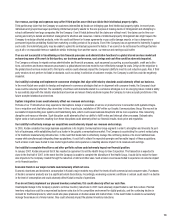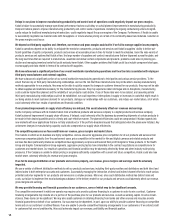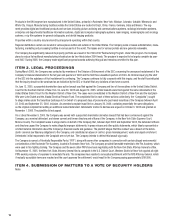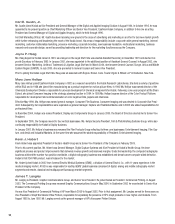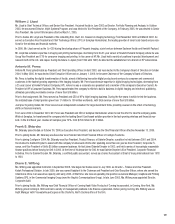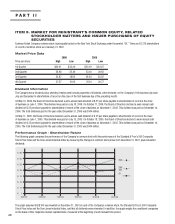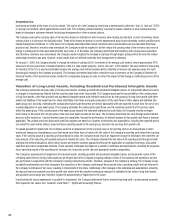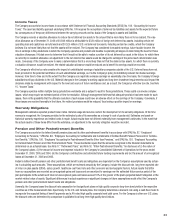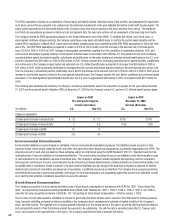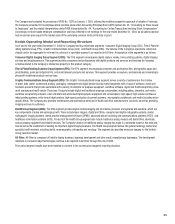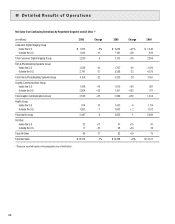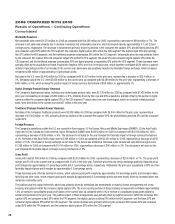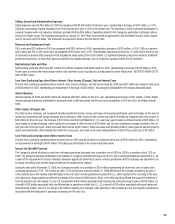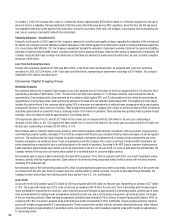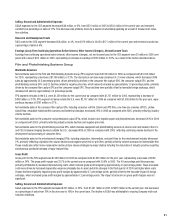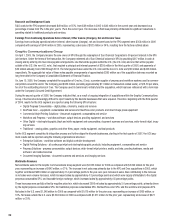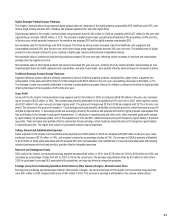Kodak 2006 Annual Report Download - page 30
Download and view the complete annual report
Please find page 30 of the 2006 Kodak annual report below. You can navigate through the pages in the report by either clicking on the pages listed below, or by using the keyword search tool below to find specific information within the annual report.
Income Taxes
The Company accounts for income taxes in accordance with Statement of Financial Accounting Standards (SFAS) No. 109, “Accounting for Income
Taxes.” The asset and liability approach underlying SFAS No. 109 requires the recognition of deferred tax liabilities and assets for the expected future
tax consequences of temporary differences between the carrying amounts and tax basis of the Company’s assets and liabilities.
The Company records a valuation allowance to reduce its net deferred tax assets to the amount that is more likely than not to be realized. The valu-
ation allowance as of December 31, 2006 of $1,849 million is attributable to $324 million of foreign net deferred tax assets, including certain net
operating loss and capital loss carryforwards and $1,525 million of U.S. net deferred tax assets, including certain tax credits, which the Company
believes it is not more likely than not that the assets will be realized. The Company has considered forecasted earnings, future taxable income, the
mix of earnings in the jurisdictions in which the Company operates and prudent and feasible tax planning strategies in determining the need for these
valuation allowances. If Kodak were to determine that it would not be able to realize a portion of its net deferred tax asset in the future, for which there
is currently no valuation allowance, an adjustment to the net deferred tax assets would be charged to earnings in the period such determination was
made. Conversely, if the Company were to make a determination that it is more likely than not that the deferred tax assets, for which there is currently
a valuation allowance, would be realized, the related valuation allowance would be reduced and a benefit to earnings would be recorded.
The Company’s effective tax rate considers the impact of undistributed earnings of subsidiary companies outside of the U.S. Deferred taxes have not
been provided for the potential remittance of such undistributed earnings, as it is the Company’s policy to indefinitely reinvest its retained earnings.
However, from time to time and to the extent that the Company can repatriate overseas earnings on essentially a tax-free basis, the Company’s foreign
subsidiaries will pay dividends to the U.S. Material changes in the Company’s working capital and long-term investment requirements could impact the
decisions made by management with respect to the level and source of future remittances and, as a result, the Company’s effective tax rate. See Note
15, “Income Taxes.”
The Company operates within multiple taxing jurisdictions worldwide and is subject to audit in these jurisdictions. These audits can involve complex
issues, which may require an extended period of time for resolution. Although management believes that adequate provision has been made for such
issues, there is the possibility that the ultimate resolution of such issues could have an adverse effect on the earnings of the Company. Conversely, if
these issues are resolved favorably in the future, the related provisions would be reduced, thus having a positive impact on earnings.
Warranty Obligations
Management estimates expected product failure rates, material usage and service costs in the development of its warranty obligations. At the time
revenue is recognized, the Company provides for the estimated costs of its warranties as a charge to cost of goods sold. Estimates are based on
historical warranty experience and related costs to repair. Actual results have not differed materially from management’s estimates. In the event that
the actual results of these items differ from the estimates, an adjustment to the warranty obligation would be recorded.
Pension and Other Postretirement Benefits
The Company accounts for its defined benefit pension plans and its other postretirement benefits in accordance with SFAS No. 87, “Employers’
Accounting for Pensions,” SFAS No. 88, “Employers’ Accounting for Settlements and Curtailments of Defined Benefit Pension Plans and for Termina-
tion Benefits,” SFAS No. 106, “Employers’ Accounting for Postretirement Benefits Other than Pensions,” and SFAS No. 158, “Employers’ Accounting
for Defined Benefit Pension and Other Postretirement Plans.” These standards require that the amounts recognized in the financial statements be
determined on an actuarial basis. See Note 17, “Retirement Plans,” and Note 18, “Other Postretirement Benefits,” for disclosure of (i) the nature of
the Company’s plans, (ii) the amount of income and expense included in the Company’s Consolidated Statement of Operations for the years ended
December 31, 2006, 2005 and 2004, (iii) the Company’s contributions and estimated future funding requirements and (iv) the amount of unrecognized
losses at December 31, 2006 and 2005.
Kodak’s defined benefit pension and other postretirement benefit costs and obligations are dependent on the Company’s assumptions used by actuar-
ies in calculating such amounts. These assumptions, which are reviewed annually by the Company, include the discount rate, long-term expected rate
of return on plan assets (EROA), salary growth, healthcare cost trend rate and other economic and demographic factors. Actual results that differ
from our assumptions are recorded as unrecognized gains and losses and are amortized to earnings over the estimated future service period of the
plan participants to the extent such total net unrecognized gains and losses exceed 10% of the greater of the plan’s projected benefit obligation or the
market-related value of assets. Significant differences in actual experience or significant changes in future assumptions would affect the Company’s
pension and other postretirement benefit costs and obligations.
Generally, the Company bases the discount rate assumption for its significant plans on high quality corporate long-term bond yields in the respective
countries as of the measurement date. Specifically, for its U.S. and Canada plans, the Company determines a discount rate using a cash flow model to
incorporate the expected timing of benefit payments and a AA-rated high quality corporate bond yield curve. For the Company’s other non-U.S. plans,
the discount rates are determined by comparison to published local long-term high quality bond indices.


